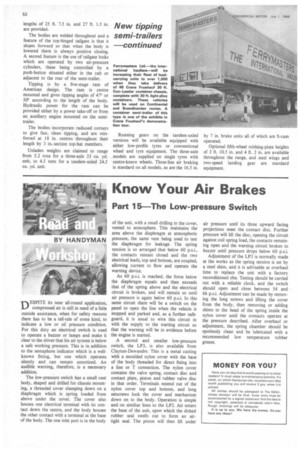Know Your Air Brakes
Page 54

If you've noticed an error in this article please click here to report it so we can fix it.
Part 15—The Low-pressure Switch
BY HANDYMAN
DESPITE its near all-round application, compressed air is still in need of a little outside assistance, when for safety reasons there has to be a tell tale of some kind, to indicate a low or nil pressure condition. For this duty an electrical switch is used to operate a buzzer or lamps and make it clear to the driver that his air system is below a safe working pressure. This is in addition to the semaphore indicator which is a wellknown fitting, but one which operates silently and can remain unnoticed. An audible warning, therefore, is a necessary addition.
The low-pressure switch has a small cast body, shaped and drilled for chassis mounting, a threaded cover clamping down on a diaphragm which is spring loaded from above under the cover. The cover also houses one electrical terminal with its contact down the centre, and the body houses the other contact with a terminal at the base of the body. The one inlet port is in the body of the unit, with a small drilling in the cover, vented to atmosphere. This maintains the area above the diaphragm at atmospheric pressure, the same vent being used to test the diaphragm for leakage. The spring tension is so arranged that below 60 p.s.i., the contacts remain closed and the two electrical leads, top and bottom, are coupled, allowing current to flow and operate the warning device.
As 60 p.s.i. is reached, the force below the diaphragm equals and then exceeds that of the spring above and the electrical circuit is broken, and will remain so until air pressure is again below 60 p.s.i. In this same circuit there will be a switch on the panel to open the line when the vehicle is stopped and parked and, as a further safeguard. it is usual to wire this circuit in with the supply to the starting circuit so that the warning will be in evidence before the engine is started.
A second and smaller low-pressure switch, the LP3, is also available from Clayton-Dewandre. This is a metal casting with a moulded nylon cover with the base of the body threaded for direct fixing into a line or T connection. The nylon cover contains the valve spring, contact disc and contact plate. piston and rubber valve disc in that order. Terminals extend out of the nylon cover top and bottom, and long setscrews lock the cover and mechanism down on to the body. Operation is simple and on similiar lines to the LP2. Air enters the base of the unit, upon which the dished rubber seal swells out to form an airtight seal. The piston will then lift under air pressure until its three upward facing projections meet the contact disc. Further pressure will lift the disc, opening the circuit against coil spring load, the contacts remaining open and the warning circuit broken to buzzer until pressure drops below 60 p.s.i.
Adjustment of the LP3 is normally made at the works as the spring tension is set by a steel shim, and it is advisable at overhaul time to replace the unit with a factory reconditioned o'ne. Testing should be carried out with a reliable clock, and the switch should open and close between 54 and 66 p.s.i. Adjustment can be made by removing the long screws and lifting the cover from the body. then removing or adding shims to the head of the spring inside the nylon cover until the contacts operate at the pressure described. After overhaul or adjustment, the spring chamber should be spotlessly clean and be lubricated with a recommended low temperature rubber grease.




























































































































